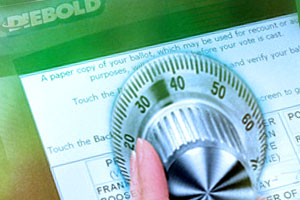Having reported extensively on the security concerns that surround the use of electronic voting machines, I anxiously awaited the results of a new study of a Diebold touch-screen voting system, conducted by Princeton University. The Princeton computer scientists obtained the Diebold system with cooperation from VelvetRevolution, an umbrella organization of more than 100 election integrity groups, which I co-founded a few months after the 2004 election. We acquired the Diebold system from an independent source and handed it over to university scientists so that, for the first time, they could analyze the hardware, software and firmware of the controversial voting system. Such an independent study had never been allowed by either Diebold or elections officials.
The results of that study, released this morning, are troubling, to say the least. They confirm many of the concerns often expressed by computer scientists and security experts, as well as election integrity activists, that electronic voting — and indeed our elections — may now be exceedingly vulnerable to the malicious whims of a single individual.
The study reveals that a computer virus can be implanted on an electronic voting machine that, in turn, could result in votes flipped for opposing candidates. According to the study, a vote for George Washington could be easily converted to a vote for Benedict Arnold, and neither the voter, nor the election officials administering the election, would ever know what happened. The virus could also be written to spread from one machine to the next and the malfeasance would likely never be discovered, the scientists said. The study was released along with a videotape demonstration.
“We’ve demonstrated that malicious code can spread like a virus from one voting machine to another, which means that a bad guy who can get access to a few machines — or only one — can infect one machine, which could infect another, stealing a few votes on each in order to steal an entire election,” said the study’s team leader, Edward W. Felten, professor of computer science and public affairs at Princeton.
The Princeton study is the first extensive investigation of the Diebold AccuVote DRE (Direct Recording Electronic) system, which is employed in Maryland, Florida, Georgia and many other states. Such touch-screen voting systems made by Diebold will be in use in nearly 40 states in this November’s elections.
Felten and a small group of Princeton computer scientists implanted a nearly undetectable virus in a Diebold voting system. They managed to alter a voter’s ballot — after it had already been confirmed and cast — and flip a vote to a candidate other than the one the voter had intended. As Felten explained, “We’ve also found how malicious code could also modify its own tracks [afterward] and remain virtually undetectable by elections officials. It wouldn’t be found in the standard tests performed either before or after an election.”
The Princeton report shows that a virus could be inserted onto a Diebold voting system by a single individual “with just one or two minutes of unsupervised access to either the voting machine or the memory card,” which is used with the system to store ballot definitions and vote tabulations.
The question of unsupervised access to voting systems has long been at the core of the debate over the use and security of electronic voting machines. That debate reached a boiling point in California’s June election, when programmed, election-ready Diebold voting machines were discovered to have been sent home overnight with poll workers on so-called sleepovers, in the days and weeks prior to the election, by San Diego County’s registrar of voters. Poll workers in the county, and many others around the country, are given voting machines by elections directors to keep at home prior to the election. They are then deployed on election morning at polling sites. The vulnerabilities to hacking, however, in the newer electronic voting systems have made that practice a topic of great concern. Earlier this year the federal certification body for e-voting systems issued a memorandum requiring greater security for such systems.
As a result of the security breaches via the voting machine “sleepovers” in San Diego County, the special election between Francine Busby and Brian Bilbray for the House seat of jailed Rep. Randy “Duke” Cunningham was contested by voting rights advocates. The legal suit charged that unrestricted access to the machines by poll workers compromised the election and violated both state and federal law.
David Jefferson, a lead voting systems technology advisor for the California secretary of state and a computer scientist at Livermore National Laboratory, told “The PBS News Hour” just after California’s primary election, “You can affect multiple machines from a single attack; that’s what makes it so dangerous.”
Jefferson’s comment was based on a


